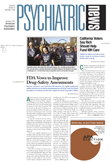Prospective payment has come to inpatient psychiatry. Last month the Centers for Medicare and Medicaid Services (CMS) published a final rule implementing a new prospective payment system (PPS) for the nation's inpatient psychiatric facilities. The new system will go into effect for payment periods beginning on or after January 1, 2005.
The new rule implements a per diem system of prospective payment—as opposed to the per-case system using diagnosis-related groups (DRGs) that has been in place for many other health care facilities since 1983—with daily rates adjusted for a host of factors that can influence the cost of care. The rule marks the end of the two-decade exemption for psychiatric facilities from prospective payment under Medicare.
Since that time, facilities offering psychiatric services were paid instead using a cost-based system under rules established by the Tax Equity and Fiscal Responsibility Act of 1982 (TEFRA).
APA leaders emphasized the landmark nature of the shift to prospective payment, a change that will entail the redistribution of billions of federal dollars for inpatient care of patients with psychiatric disorders.
“The new prospective payment system is an important step forward in payment for inpatient psychiatric care under the Medicare program, as the TEFRA payment method has proven problematic for many providers,” said APA President-elect Steven Sharfstein, M.D.
Joseph T. English, M.D., a leader in APA's negotiations with the government around reimbursement for inpatient psychiatry for the past two decades, said APA has been heavily involved in working with the government to develop a workable system of prospective payment for inpatient psychiatry.
He noted that APA has also partnered with the Health Economics and Outcomes Research Institute (THEORI), a consultant group linked to the Greater New York Hospital Association, in developing a method of data collection for reimbursement under the new system that relies on existing Medicare claims data.
That method replaces a government proposal that would have required psychiatric hospitals to use a lengthy, costly, and time-consuming “new patient assessment” instrument to collect data.
“The major point is that the methodology we developed does not place another major administrative burden on the hospital or the clinician,” English said. “It means that hospitals that provide psychiatric services will be reimbursed by a method that allocates resources fairly and based on information that the hospital already collects.”
He is a past president of APA and current chair of APA's Committee on Reimbursement for Psychiatric Care. He is also chair of the Mental Health and Substance Abuse Committee of the Greater New York Hospital Association, as well as chair of psychiatry at St. Vincent Catholic Medical Centers and professor and chair of psychiatry at New York Medical College.
It was English who led the effort two decades ago to exempt inpatient psychiatry from prospective payment based on the system of DRGs used for general hospitals and other health care facilities. That exemption spared hospital-based psychiatry a reimbursement system that would have cost the hospitals roughly $200 million a year in lost funding, or $4 billion over the 20-year period, English told Psychiatric News.
English noted that the redistribution of resources under the new payment system will mean, invariably, that there will be winners and losers. Exactly how the new system will affect individual hospitals remains to be seen, however.
An analysis of the new rule is being conducted by APA's Office of Healthcare Systems and Financing, the APA Committee on Reimbursement for Psychiatric Care, and THEORI. When the review is complete, a report on how the rule may affect hospitals in general will appear in Psychiatric News.
During the first cost-reporting period after the rule goes into effect in January, hospitals will receive a 25 percent/75 percent blend of PPS and TEFRA payment methodologies, with a staged increase in prospective payment until July 1, 2008, by which time all hospitals will be reimbursed under the new PPS.
The final rule includes the following key provisions, according to a preliminary reading by APA's Office of Healthcare Systems and Financing:
•
Emergency department adjustment: A 12 percent payment increase on the first day of the stay for all patients admitted to facilities with a full-service emergency department is included in the rule.
•
Comorbidities: The number of comorbidities that qualify for a payment increase due to the higher costs of more medically complex patients has been increased.
•
ECT: An additional payment of $247.96 for ECT services has been included.
•
Age adjustment: The rule includes eight age-adjustment factors, beginning with groups of patients under 45 and progressing to groups of patients over 80.
•
Rural adjustment: Psychiatric facilities located in rural areas will receive a 17 percent payment increase.
•
Stop loss: CMS has developed a stoploss protection for hospitals that experience extreme losses. The stop loss applies to rural facilities with PPS payments that are less than 70 percent of their original TEFRA payments.
•
Interrupted-stay policy: CMS has created an interrupted-stay policy that would be applied when a patient is discharged from a facility and returns to the same facility within three consecutive calendar days. In such situations, CMS will treat the two admissions as one and pay accordingly.
Medicare's final rule for prospective payment for inpatient psychiatric facilities is posted online at<www.cms.hhs.gov/providers/ipfpps/cms-1213-f.pdf>.▪
